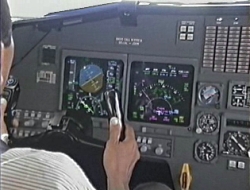Boeing 787 Dreamliner's APU battery location over inspection by NTSB
BATTERY CELLS DESIGNED FOR AIRCRAFT
POWER USAGE
O que é uma célula eletroquimica?
Bolhas de plástico para auto "cicatrização" de rachaduras no ânodo da bateria Litio-íon
A
lithium-ion battery has three basic parts. At one end is the cathode, which
has a positive electric charge. At the other end is an anode, which is
negatively charged. A liquid called an electrolyte carries charges between
the cathode and the anode. In lithium-ion batteries, the electrolyte contains
atoms of lithium that have positive charges. These charged atoms are called
ions.
|
Uma bateria de Lítio-íon tem três
partes básicas. Numa ponta está o Cátodo, o qual tem uma carga elétrica
positiva. Na
outra ponta está o Ânodo, o qual é carregado negativamente. Um líquido chamado eletrólito carrega cargas entre o cátodo e o ânodo.
Em baterias Lítio-íon, o eletrólito contém átomos de Lítio que têm cargas
positivas. Estes átomos carregados são chamados íons.
|
The
scientists knew that tiny cracks, which can often form in the anode, can
block the electric current and eventually kill a battery. To combat the
cracks, the scientists added a little something extra into the anode: tiny plastic
bubbles, or spheres, filled with a material called gallium indium. When the
anode develops tiny cracks, some of these bubbles break open and spill the
gallium indium. This material can seal the crack, so that the battery can
conduct electricity again which means the battery will be back up and
running.
|
Os cientistas sabiam que pequenas
rachaduras, as quais podem frequentemente formar no ânodo, podem bloquear a
corrente elétrica e eventualmente descarregar a bateria. Para, combater
as rachaduras os cientistas acrescentaram um pouco de algo extra no ânodo:
pequenas bolhas de plástico, ou esferas, preenchidas com um material chamado
Galio Indio. Quando o ânodo desenvolve pequenas rachaduras, algumas destas
bolhas rompem-se e derramam o Galio Indio. Este material pode selar a
rachadura, tal que a bateria possa conduzir eletricidade novamente, o que
significa que a bateria será sustentada e funcionará.
|
The
scientists say this idea can also be used to build safer batteries. Damaged
lithium-ion batteries have been known to overheat and catch on fire.
|
Os cientistas dizem que esta ideia
pode também ser usada para construir baterias mais seguras. Baterias de
Lítio-íon danificadas têm sido conhecidas por sobreaquecer e pegar fogo.
|
They
say another type of tiny sphere could be used to stop battery fires before
they start. These bubbles, made from cheap plastic, are designed so that they
melt if the temperature in the battery gets too high. Plastic does not
conduct electricity. When the plastic bubbles melt, they stop the current
within the battery, cooling it down.
|
Eles dizem que um outro tipo de
pequenas esferas poderiam ser usadas para parar incêndio em baterias, antes
deles começarem. Estas bolhas, feitas de plástico barato, são projetadas tal
que elas derretem, se a temperatura na bateria ficar muito alta. Plástico não
conduz eletricidade. Quando as bolhas de plástico derretem, elas param a
corrente dentro da bateria, a esfriando.
|
Bateria Li-ion danificada e outra bateria com as bolhas de plástico
The
battery cells that were tested were all commercial off-the-shelf products
that are being considered by manufacturers for aircraft power-related usage.
|
As células de baterias que foram
testadas eram todas produtos comerciais de prateleiras que estavam sendo
consideradas pelos fabricantes para uso relacionado com força elétrica em
aeronave.
|
The
results of the tests showed that the lithium-ion and lithium-ion polymer
battery cells can react violently when exposed to an external fire. Under
test conditions, when the battery cells failed, flammable electrolyte was
released and ignited, which further fueled the existing fire. This release
and ignition of the electrolyte resulted in significant temperature and
pressure increases within the test fixtures.
|
Os resultados dos testes mostraram que
células de bateria de Lítio-ion e células Lítio-ion polímero podem reagir
violentamente quando expostas a um fogo externo. Sob condições de teste,
quando as células de bateria falharam, eletrólito imflamável foi liberado e
pegou fogo, o que além disso abasteceu
com combustível o fogo existente. Esta liberação e ignição do eletrólito
resultou em aumentos de temperatura e pressão significantes entro das
instalações de teste.
|
Tests
conducted with a hand-held Halon 1211 fire extinguisher showed that the halon
was able to extinguish all three battery-type fires. However, even after
several attempts, the halon extinguishing agent was not able to prevent the
lithium-ion polymer battery cells, which are of a different chemistry, as
well as a much higher energy density and power capacity, from reigniting.
|
Testes conduzidos com um extintor de
fogo manual com Halon 1211 mostrou que o halon foi capaz de extinguir todos
três fogos de tipos de bateria. Todavia, mesmo após várias tentativas, o
agente halo de extinção não foi capaz de impedir as células da bateria
Lítio-ion polímero, as quais eram de uma qúimica diferente tanto quanto de
uma mais alta densidade de energia e capacidade elétrica, de reignição.
|
Rechargeable
lithium-ion batteries offer many advantages over current battery
technologies. They possess a high-energy density per unit volume, relatively
constant voltage during discharge, low maintenance, good low-temperature
performance, and a long shelf life. There is, however, a certain amount of
hazard associated with the use of these batteries due to their high-energy
content and potential thermal instability. Their proposed use onboard
aircraft as power sources for starting aircraft engines or auxiliary power
units, as well as other avionics, emergency, and standby systems, require the
examination of the safety of their design. How these batteries will react in
a fire situation and what type of fire hazard they pose themselves must be
examined. Tests must be performed to ensure the batteries provide an
appropriate level of safety. Current regulatory and test requirements may
need to be updated to address the hazards associated with this new
technology.
|
Baterias de Lítio-íon recarregáveis
oferecem muitas vantagens sobre tecnologias de baterias atuais. Elas possuem
uma densidade de energia alta por unidade de volume, relativamente voltagem
constante durante descarga, baixa manutenção, performance boa em temperatura
baixa e uma longa vida de prateleira. Há, porém, uma certa quantidade de
risco associado com o uso destas baterias devido à instabilidade termo potencial
e conteudo de alta energia. O uso proposto delas a bordo de aeronave como
fontes de força elétrica para dar partida em motores de aeronave ou unidades
auxiliares de força, tanto quanto outros sistemas avionicos, emergência e
auxiliares, exige a examinação da segurança do projeto delas. Como estas
baterias reagirão numa situação de fogo e qual tipo de risco de fogo elas se
postam, devem ser examinadas. Exigências e regulamentação atuais podem
necessitar de serem atualizadas para tratar os riscos associados com esta
nova tecnologia.
|
Attempts
to cause the battery cells to reach their thermal runaway point via short
circuiting were unsuccessful on all three battery types.
|
Tentativas para causar às células de
bateria a atingir o ponto de fuga termal delas via curto-circuito foram mal
sucedidos em todos três tipos de baterias.
|
NTSB photos
of the burned auxiliary power unit battery from a JAL Boeing 787 that caught
fire on Jan. 7 at Boston's Logan International Airport. The dimensions of the
battery are 19x13.2x10.2 inches and it weighs approximately 63 pounds (new).
Fotos
da NTSB da bateria da Unidade Auxiliar de Força [APU] do Boeing 787 da Japan
Air Lines que pegou fogo em 07 JAN 2013 no aeroporto internacional Logan de
Boston. As dimensões da bateria são 48.2 x 33.5 x 25.9 centímetros e ela pesa
aproximadamente 28.6 Kg (nova).
Original pictures by NTSB
Open them in new tab for seeing them magnified
Open them in new tab for seeing them magnified
















Nenhum comentário:
Postar um comentário